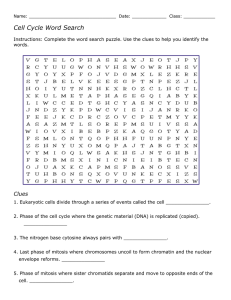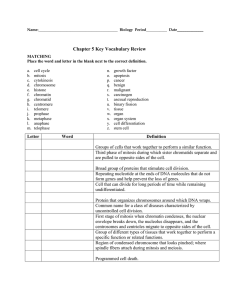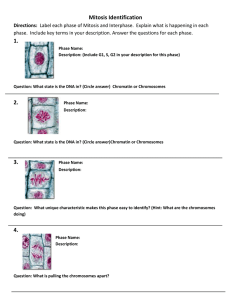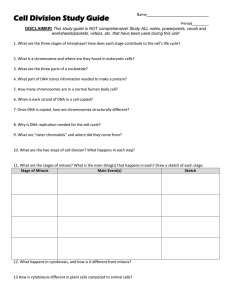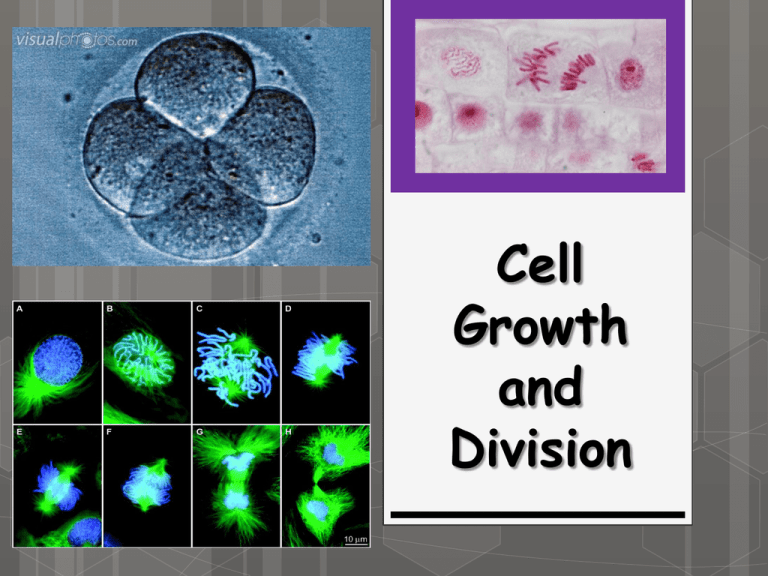
Cell
Growth
and
Division
Things to ponder…
When living things grow, what happens to its cells?
?
OR
?
Things to ponder…
When living things grow, what happens to its cells?
For example: When a 7lb baby grows into a 70lb child is it
because its cells grow bigger or because it made more
cells?
Things to ponder…
When living things grow, what happens to its cells?
For example: When a 7lb baby grows into a 70lb child is it
because its cells grow bigger or because it made more
cells?
What would happen if a cell where just split into two
without any preparation? Would the two new cells have
everything they would need to survive?
?
Objectives
Describe the stages of the cell cycle, including DNA
replication and mitosis, and the importance of the cell
cycle to the growth of organisms (TEKS 5A)
• Describe how cell division solves the problems of cell
growth.
• Name the main events and components of the cell cycle
• Describe what happens during the 4 phases of mitosis
Limits to Cell Growth
The larger a cell becomes, the more demands the cell places
on its DNA. In addition, the cell has more trouble moving
enough nutrients and wastes across the cell membrane.
If cells just grew larger…
DNA would get “overloaded”
• As a cell increases in size, it usually doesn’t make more DNA.
• The same amount of DNA would then be forced to control a much larger
cell causing an “information crisis”
Limits to Cell Growth
The larger a cell becomes, the more demands the cell places
on its DNA. In addition, the cell has more trouble moving
enough nutrients and wastes across the cell membrane.
If cells just grew larger…
Exchanging materials would also become more difficult
•
•
•
Food, oxygen, and water enter a cell through the cell membrane and wastes exit through
this same membrane
The cells surface area and volume are critical to the cells ability to efficiently do this.
As a cell grows, its volume increases more rapidly than its surface area limiting what can
come into or out of the cell. It’s like a highway in Houston vs a highway in Huntsville.
Made more cells…Cell Division!
When a 7lb baby grows into a 70lb child is it because its
cells grow bigger or because it made more cells?
Cell division, however, is
just one small part of
the cell cycle
Objectives
Describe the stages of the cell cycle, including DNA
replication and mitosis, and the importance of the cell
cycle to the growth of organisms (TEKS 5A)
• Describe how cell division solves the problems of cell
growth.
• Name the main events and components of the cell cycle
• Describe what happens during the 4 phases of mitosis
The Cell Cycle
During the cell cycle, a cell grows, prepares for division, and divides
to form two daughter cells, each of which then begins the cycle
again.
Interphase-The longest part
of the cell cycle. It has 3
phases.
• G1 phase- a growth phase.
Cells increase in size and
synthesize new proteins
and organelles.
• S phase- Chromosomes
(DNA) are replicated
• G2 phase- another growth
phase. Organelles are
duplicated and the cell
prepares for cell division
Cell Division– Also called
M phase. Has 2 phases.
• Mitosis- First stage of
cell division. It’s made
up of 4 stages
• Cytokinesis- Final
stage of division when
the cytoplasm divides
and separates to form
two daughter cells.
Things to ponder…
When living things grow, what happens to its cells?
For example: When a 7lb baby grows into a 70lb child is it
because its cells grow bigger or because it made more
cells?
What would happen if a cell where just split into two
without any preparation? Would the two new cells have
everything they would need to survive?
Answer:
?
NO
Cell Division:
Background Info
The who, what, where, when,
why, and how of cell division
Who’s dividing:
The cell, specifically somatic or
asexual cells
Where does it start: The
nucleus
When does it divide:
During mitosis (M phase)
Why does it divide:
To make more cells (to grow)
How does this happen:
I’m glad you asked…
Cell Division:
How it happens
Every cell must copy its genetic information before
cell division can begin.
• In prokaryotes (aka bacteria) cells undergo a much
simpler version of cell division called binary
fission…but we won’t focus on this today.
• In eukaryotes, cell division is more complex mainly
due to the complexity of cell itself (more organelles,
more DNA, etc)
• The two main stages of cell division are mitosis and
cytokinesis
• Do you remember at what stage of the cell cycle is
genetic information copied?
Cell Division:
What’s a chromosome?
Every cell must copy its genetic information
before cell division can begin.
Chromosomes contain that genetic information.
Chromosomes are simply DNA wound up into a
threadlike structure found in the nucleus.
Chromosomes are not visible in most cells except during
cell division.
During S phase, each chromosome is duplicated or
copied creating an identical sister chromatid.
At the end of cell division, the two new daughter cells
will each have one of those sister chromatids; thereby
making two cells with identical chromosomes.
Humans have 46 chromosomes, or 23 pairs.
• One chromosome is paternal (means it comes from the father)
• One chromosome is maternal (means it comes from the mother)
The figure below is called a karyotype. It’s a set of human
chromosomes arranged in order from 1-22 with the sex
chromosomes being last.
Objectives
Describe the stages of the cell cycle, including DNA
replication and mitosis, and the importance of the cell
cycle to the growth of organisms (TEKS 5A)
• Describe how cell division solves the problems of cell
growth.
• Name the main events and components of the cell cycle
• Describe what happens during the 4 phases of mitosis
Cell Division:
Mitosis
There are 4 main stages of mitosis
PROPHASE
1st dividing phase
• DNA thickens and becomes visible
• Centrioles appear in centrosome region
& move to poles
• Nuclear membrane & nucleolus disappear
• Spindle fibers form & attach to
chromosomes
CENTROSOME
________
region organizes spindle
Spindle MICROTUBULES are part of cytoskeleton
METAPHASE
Chromosomes line up in
middle
___________
ANAPHASE
Centromeres split
apart
Centrioles pull chromatids_______
Each chromatid
is now its own
chromosome
TELOPHASE
two nuclei
See ______
• Nuclear membrane & nucleolus return
• Chromosomes spread out at opposite
ends of the cell
• Spindle fibers disappear
Images from:
Pearson Eduction Ince; Publishing as Pearson Prentice Hall
http://www2.bc.cc.ca.us/cnewton/Biology%2011/Mitosis.html
Final stage of cell division is:
CYTOKINESIS
Cytoplasm splits into 2 cells



